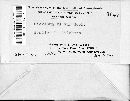Dicranum fulvum
|
|
|
|
Family: Dicranaceae
|
Plants in loose tufts, dark green above, blackish green below, dull. Stems 1.5-3.5 cm, sparsely tomentose with light- to reddish brown rhizoids. Leaves erect-spreading, some weakly falcate-secund, crisped when dry, smooth, (3-)4-5(-7) × 0.5-0.8 mm, some leaf tips broken off, concave below, subtubulose above, narrowly lanceolate to a long, narrow subula occupied mainly by the excurrent costa, apex acute; margins serrate to serrulate in distal half; laminae 1- or 2-stratose above, sometimes 2-stratose in patches; costa excurrent, 1/4-1/3 the width of the leaves at base, abaxially toothed or papillose in distal half, abaxial ridges absent, with a row of guide cells, two stereid bands not extending above the leaf middle, adaxial and abaxial epidermal layers of cells somewhat differentiated or with a few cells enlarged in both layers, cell walls between lamina cells strongly bulging in distal part of leaf lamina; leaf cells smooth or abaxially prorate above; alar cells mostly 1-stratose or sometimes with a few 2-stratose cells, distinctly differentiated, often extending to costa; proximal laminal cells elongate-rectangular, not pitted or with few pits, (19-)24-33(-42) × (4)5-6(9) µm; distal laminal cells regularly quadrate to short-rectangular, not pitted, (5-)10-11(-16) × (4)5-6(9) µm. Sexual condition dioicous; male plants as tall as female plants but usually more slender; interior perichaetial leaves abruptly long-acuminate, convolute-sheathing. Seta 1-2 cm., solitary, brown or reddish brown. Capsule 1.5-3 mm, straight and erect, smooth, slightly furrowed when dry, reddish brown; operculum 1.5-2 mm. Spores 14-28 µm. Capsules mature in spring. Sandstone, limestone or acidic rock outcrops, bluffs, cliff faces, and boulders in deciduous woodlands, especially along streams; rarely on bases of tree trunks, fallen trees and logs; 200-1900 m; N.B., N.S., Ont., Que.; Ala, Ark., Conn., D.C., Ga., Ill., Ind., Iowa, Ky., Maine, Md., Mass., Mich., Minn., Miss., Mo., N.H., N.J., N.Y., N.C., Ohio, Okla., Pa., R.I., S.C., Tenn., Vt., Va., W.Va., Wis.; Europe; Asia. Dicranum fulvum has dull, blackish green plants, especially evident from the leaves on the basal part of the stems, leaves crisped when dry, broad costae that cover 1/4-1/3 the width of the leaves at base, laminae that are mostly 2-stratose in the distal half of the leaf, and erect, cylindrical capsules that are slightly furrowed when dry. It is sometimes confused with D. fuscescens but that species has keeled leaves in the distal half, with 2-stratose regions restricted to the margins, and horizontal capsules, whereas D. fulvum has subtubulose leaves, with almost entirely 2-stratose laminae above, and erect capsules. When D. fulvum has some of its leaf apices broken off, which is not uncommon, it can be confused with D. viride, which has the majority of its leaf tips absent. The usual occurrence on rock of plants of D. fulvum as opposed to the usual occurrence on bases of tree trunks of D. viride often gives some clue to their identity. Morphologically, the proximal leaf cells of the two differ: D. fulvum has shorter cells, averaging 24-33 µm, compared to the longer cells of D. viride, averaging 33-42 µm.
|












































































